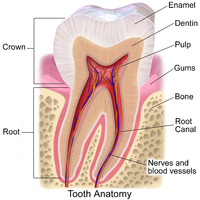
Photo from wikipedia
Direct pulp-capping, a vital pulp therapy, is used to protect and preserve pulp vitality by applying a biomaterial on the pulp exposure site. Acemannan, a polysaccharide extracted from Aloe vera,… Click to show full abstract
Direct pulp-capping, a vital pulp therapy, is used to protect and preserve pulp vitality by applying a biomaterial on the pulp exposure site. Acemannan, a polysaccharide extracted from Aloe vera, induces osteodentin-bridge formation to cover the exposure site in vivo. We evaluated the effect of acemannan sponges on partial pulpotomized permanent teeth with caries or accident-induced pulp exposure (n = 50). After removing infected dentin and inflamed pulp tissue, the teeth were randomly divided into acemannan or control (mineral trioxide aggregate (MTA) groups (n = 25). The teeth were examined immediately after treatment (baseline) and at 6- and 12-month follow-ups for clinical and cone beam computed tomography (CBCT) examination. The three-dimensional tooth length and root apex area were simulated to determine treatment success. We found that the overall success rate in the acemannan and MTA groups from baseline to 12-month follow-up was 90.91% and 95.65%, respectively, with no significant difference between the two groups (p > 0.05). In the success teeth in both groups, the root length increased, and the apex area significantly decreased (p < 0.05), indicating continued root formation. Our results suggest that acemannan is a promising low-cost biomaterial for partial pulpotomy treatment for immature permanent teeth requiring vital pulp therapy.
Journal Title: Pharmaceutics
Year Published: 2020
Link to full text (if available)
Share on Social Media: Sign Up to like & get
recommendations!